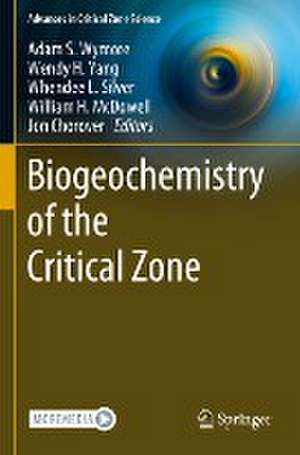Biogeochemistry of the Critical Zone: Advances in Critical Zone Science
Editat de Adam S. Wymore, Wendy H. Yang, Whendee L. Silver, William H. McDowell, Jon Choroveren Limba Engleză Paperback – 18 mai 2023
Biogeochemical processes are at the heart of energy and matter fluxes through ecosystems and watersheds. They control thequantity and quality of carbon and nutrients available for living organisms, control the retention and export of nutrients affecting water quality and soil fertility, and influence the ability for ecosystems to sequester carbon. As the term implies, biogeochemical cycles, and the rates at which they occur, result from the interaction of biological, chemical, and physical processes. However, finding a unifying framework by which to study these interactions is challenging, and the different components of bio-geo-chemistry are often studied in isolation. The authors provide both reviews and original research contributions with the requirement that the chapters incorporate a CZ framework to test biogeochemical theory and/or develop new and robust predictive models regarding elemental cycles. The book demonstrates how the CZ framework provides novel insights into biogeochemistry.
| Toate formatele și edițiile | Preț | Express |
|---|---|---|
| Paperback (1) | 940.57 lei 6-8 săpt. | |
| Springer International Publishing – 18 mai 2023 | 940.57 lei 6-8 săpt. | |
| Hardback (1) | 946.55 lei 6-8 săpt. | |
| Springer International Publishing – 17 mai 2022 | 946.55 lei 6-8 săpt. |
Preț: 940.57 lei
Preț vechi: 1147.03 lei
-18% Nou
Puncte Express: 1411
Preț estimativ în valută:
180.00€ • 185.95$ • 149.81£
180.00€ • 185.95$ • 149.81£
Carte tipărită la comandă
Livrare economică 26 martie-09 aprilie
Preluare comenzi: 021 569.72.76
Specificații
ISBN-13: 9783030959234
ISBN-10: 3030959236
Pagini: 202
Ilustrații: IX, 202 p. 63 illus., 59 illus. in color.
Dimensiuni: 155 x 235 mm
Greutate: 0.3 kg
Ediția:1st ed. 2022
Editura: Springer International Publishing
Colecția Springer
Seria Advances in Critical Zone Science
Locul publicării:Cham, Switzerland
ISBN-10: 3030959236
Pagini: 202
Ilustrații: IX, 202 p. 63 illus., 59 illus. in color.
Dimensiuni: 155 x 235 mm
Greutate: 0.3 kg
Ediția:1st ed. 2022
Editura: Springer International Publishing
Colecția Springer
Seria Advances in Critical Zone Science
Locul publicării:Cham, Switzerland
Cuprins
An Introduction to Biogeochemistry of the Critical Zone.- Hot Spots and Hot Moments in the Critical Zone: Identification of and Incorporation into Reactive Transport Models.- Constraints of Climate and Age on Soil Development in Hawai‘i.- Biofilms in the Critical Zone: Distribution and Mediation of Processe.- Eroded Critical Zone Carbon and Where to Find It: Examples from the IML-CZO.- Advances in Biogeochemical Modeling for Intensively Managed Landscapes.- Hillslope Position and Land-Use History Influence P Distribution in the Critical Zone.
Textul de pe ultima copertă
This book highlights recent advances in the discipline of biogeochemistry that have directly resulted from the development of critical zone (CZ) science. The earth's critical zone (CZ) is defined from the weathering front and lowest extent of freely circulating groundwater up through the regolith and to the top of the vegetative canopy. The structure and function of the CZ is shaped through tectonic, lithologic, hydrologic, climatic, and biological processes and is the result of processes occurring at multiple time scales from eons to seconds. The CZ is an open system in which energy and matter are both transported and transformed. Critical zone science provides a novel and unifying framework to consider those coupled interactions that control biogeochemical cycles and fluxes of energy and matter that are critical to sustaining a habitable planet.
Biogeochemical processes are at the heart of energy and matter fluxes through ecosystems and watersheds. They control thequantity and quality of carbon and nutrients available for living organisms, control the retention and export of nutrients affecting water quality and soil fertility, and influence the ability for ecosystems to sequester carbon. As the term implies, biogeochemical cycles, and the rates at which they occur, result from the interaction of biological, chemical, and physical processes. However, finding a unifying framework by which to study these interactions is challenging, and the different components of bio-geo-chemistry are often studied in isolation. The authors provide both reviews and original research contributions with the requirement that the chapters incorporate a CZ framework to test biogeochemical theory and/or develop new and robust predictive models regarding elemental cycles. The book demonstrates how the CZ framework provides novel insights into biogeochemistry.
Biogeochemical processes are at the heart of energy and matter fluxes through ecosystems and watersheds. They control thequantity and quality of carbon and nutrients available for living organisms, control the retention and export of nutrients affecting water quality and soil fertility, and influence the ability for ecosystems to sequester carbon. As the term implies, biogeochemical cycles, and the rates at which they occur, result from the interaction of biological, chemical, and physical processes. However, finding a unifying framework by which to study these interactions is challenging, and the different components of bio-geo-chemistry are often studied in isolation. The authors provide both reviews and original research contributions with the requirement that the chapters incorporate a CZ framework to test biogeochemical theory and/or develop new and robust predictive models regarding elemental cycles. The book demonstrates how the CZ framework provides novel insights into biogeochemistry.
Caracteristici
Combines biogeochemistry with critical zone science Highlights recent advances in biogeochemistry focusing on CZ sciences Covers both terrestrial and aquatic systems
